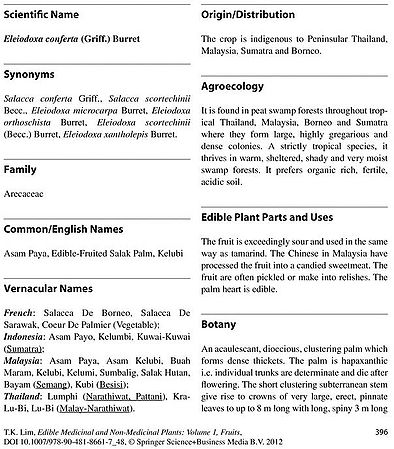Eleiodoxa conferta
| Eleiodoxa (ee-lee-oh-DOHKS-ah) conferta (kohn-FEHR-tah) | |||||||
|---|---|---|---|---|---|---|---|
 | |||||||
| Scientific Classification | |||||||
| |||||||
| Synonyms | |||||||
|
| |||||||
| Native Continent | |||||||
|
| |||||||
| Morphology | |||||||
| |||||||
| Culture | |||||||
|
| |||||||
| Survivability index | |||||||
|
| |||||||
| Common names | |||||||
|
| |||||||
Contents
Habitat and Distribution
Borneo, Malaya, Sumatera, and tropical Thailand. Freshwater swamps, they are highly gregarious. often forming large colonies. especially abundant in peat swamp forest with some water movement.
Description
While remaining underground, the trunks of these palms are clustering and form dense thickets. As one of the few hapaxanthic in the family, individual trunks are determinate and die after flowering. A mature leaf reaches 3.5 m in length on 3 m petioles which are armed with whorls of 5 – 7 cm long spines. The green to deep green pinnae are regularly arranged along the rachis, 1.5 m in length, and toothed along the margins. The inflorescence emerges at ground level, bearing either male or female flowers, in the latter forming scaly, red fruit with one or occasionally two seeds. (Paul Craft) Editing by edric.
Culture
When this palm is cultivated it demands generous water, and rich, acidic soil and shade or filtered light. Cold Hardiness Zone: 10b
Comments and Curiosities
Etymology: The genus is named from two Greek words meaning "water" and "glory" and the species name is Latin for "congested", an allusion to the flower spike.
A Hapaxanthic palm, individual trunks grow for some years before they flower, but then die after flowering.
A dioecious species, both male and female forms need to be grown if fruit and seed are required.
Uses: This species is widely used by local people throughout its range, providing food and materials. The fruit is often sold in local markets. Fruit - cooked. Intensely acid, it is used to flavour curries or is boiled to make sweetmeats. It can be used as a substitute for tamarind (Tamarindus indicus).
A decoction of the fruit wall is used as a treatment against coughs. The leaves are used for thatching and are woven into mats.
Apical bud - cooked and eaten as a vegetable. Although harvesting the bud will lead to the death of that trunk (since it is unable to make side shoots), the plant produces new trunks from the underground stem and so it is possible to sustainably harvest the buds if picked in moderation.
Kelubi fruit are usually processed into sweets, sour mix vegetables, mixed salad, sauce or raw materials. Often the fruit is found in Sumatra and Kalimantan. Sumatra community usually as a raw material processing kelubi sweets. You do this by peeling the fruit is old and mature. Soak the fruit in a solution of salt, one pound of fruit needed for 150 g of sugar and 2 tablespoons of table salt.
Eleiodoxa conferta (Griff.) Burret. Arecaceae. CN: [Malay - Asam paya, Asam kelubi, Kelubi, Kelumi, Salak hutan], Asam payo, Kuwai-kuwai, Kelumbi. Eleiodoxa is a monotypic genus, dioecious, lowland forest freshwater swamp-dwelling plant, native to South East Asia (Thailand, Malaysia, Borneo and Sumatra) where they form large colonies. While remaining underground, the trunks of these palms are clustering and form dense thickets up to about 6 m tall. Fruit edible but extremely sour and astringent; usually pickled before consumption and for preparing special culinary in certain cultures especially involving freshwater fish. In ethno-medicine, there are claims the Chinese use the scaly husk of the fruit as cough mixture. It has also been reputed to be an antidote for the poisoning of Antiaris. A decoction of the pounded stem is used to relieve cough and hoarseness. This plant is applied as a paste to treat orchitis and is believed capable of relieving headache.
- IMAGE GALLERY
External Links
- Glossary of Palm Terms
- MODERN BOTANICAL LATIN
- "Just To Be Clear"
- https://www.youtube.com/watch?v=3A7vbnqOtHg
- http://florasingapura.com/Fresh-Water-Swamp-Forest.php
- http://www.rainforestjournal.com/sungai-menyala-forest-reserve-port-dickson/
References
Phonetic spelling of Latin names by edric.
Special thanks to Geoff Stein, (Palmbob) for his hundreds of photos.
Special thanks to Palmweb.org, Dr. John Dransfield, Dr. Bill Baker & team, for their volumes of information and photos.
Glossary of Palm Terms; Based on the glossary in Dransfield, J., N.W. Uhl, C.B. Asmussen-Lange, W.J. Baker, M.M. Harley & C.E. Lewis. 2008. Genera Palmarum - Evolution and Classification of the Palms. Royal Botanic Gardens, Kew. All images copyright of the artists and photographers (see images for credits).
Many Special Thanks to Ed Vaile for his long hours of tireless editing and numerous contributions.
























































